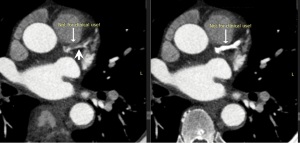by
John R. Fischer, Senior Reporter | July 06, 2021

Mayo Clinic has performed the first cardiac scan with its new photon-counting-detector CT scanner
Researchers at Mayo Clinic in Rochester have performed the first cardiac scan with their new photon-counting detector CT scanner.
The scanner is fast enough to provide clear images of the heart and blood vessels and is part of an ongoing collaboration with Siemens Healthineers.
"We've already performed studies that demonstrate that the extra detail allows physicians to be much more confident in their diagnosis and to be able to resolve features of disease that previously were not able to be differentiated. The ability to get that spatial resolution and energy-resolved (spectral) information opens up many new clinical indications," said Dr. Cynthia McCollough, director of Mayo Clinic's CT Clinical Innovation Center, told HCB News.



Ad Statistics
Times Displayed: 172944
Times Visited: 3140 For those who need to move fast and expand clinical capabilities -- and would love new equipment -- the uCT 550 Advance offers a new fully configured 80-slice CT in up to 2 weeks with routine maintenance and parts and Software Upgrades for Life™ included.
Photon-counting detectors have provided CT with the best spatial resolution that researchers have seen and makes it fast enough to capture a small fraction of one heartbeat by 'freezing' the motion, according to McCollough. The spectral information they can collect with this technology also can be used to suppress or enhance the signal from important material, such as calcium, fat or iodine.
Traditionally, photon-counting detectors could not be used in CT imaging because they were unable to keep up with the rate of photons reaching the detector. Its CT Clinical Innovation Center assessed research systems that could overcome this challenge and teamed up with Siemens Healthineers, which developed the prototype system. Using a unique geometry, the solution was able to perform state-of-the-art cardiac imaging.
The world’s first photon-counting detector CT system was installed in 2014, with the first research studies in humans beginning in August 2015. A second-generation prototype was installed in 2020 and addressed many of the design limitations of the first, including a 20% reduction in slice thickness, a greater field of view, better data handling speeds and the ability to perform image reconstruction online.
These capabilities can also be found in the third-generation research system, which now also includes cardiac gating capabilities. It is the first of its kind in North America and has been running since April as part of the ongoing research collaboration with Siemens. It was recently used in April to perform the first cardiac scan for Mayo Clinic.
"This will be a game changer for coronary artery imaging, where not only are the vessels very small (a few millimeters), but they are moving very rapidly," said McCollough. "Also, the technology is inherently digital, which means certain sources of uncertainty in the data are no longer there. This makes the data very robust and information can be measured more accurately. This is a tremendous advantage for artificial intelligence applications."
More research on increasing mass production of photon-counting-detector material in sufficient volumes is required before the commercialization of the system can be considered, according to McCullough.
The CT Clinical Innovation Center has partnered with radiologists to create research teams that will assess how to apply the technology in nine subspecialties, including for improved diagnosis of lung and vascular diseases.

